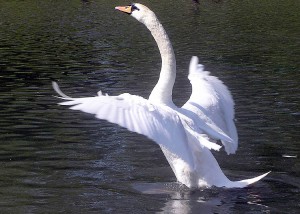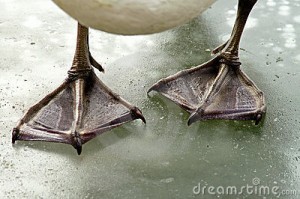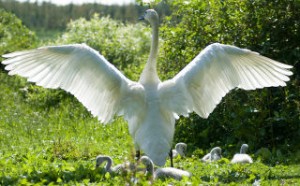
Elegant yet notoriously aggressive, a swan is not only one of the largest birds to fly, but it is also very unique. Being mostly aquatic, it makes sense that this bird would have webbed feet. However, this has been shown to not only be for better control and movement in the water, but also an extensive adaptation to their flight.

Weighing in at anywhere from 22 to 33 lbs, this bird is just a few pounds less than the heaviest bird that is still capable of flight: the Kori Bustard. The Kori Bustard, a horribly clumsy flier, struggles greatly to get up into the air and doesn’t tend to stay up for very long, so how is it that the swan can achieve flight from the water without a moving start?
Here is where their adaptations come into play. We all know very well that wet wings wont fly. This is shown by the post “A Kettle of Bald Eagles”, where the bald eagle picks up a fish that is too large for it to fly away and falls in the water. When this happens it is forced to “swim” its way to shore to dry its wings.
The Swan, on the other hand, has a gland, the ‘preen gland’, at the base of its tail that secrets water-resistant oil. Using its long neck, it reaches back and uses it’s bill to spread the oil across its feathers. This allows it to spend as much time as it wants in the water without needing to dry off.
A Swan’s wingspan ranges from a massive 79-138 inches, allowing for long and powerful downstrokes to counteract its weight and give it forward motion.

Even with waterproofed feathers and large wings, it is still a considerable feat for this animal to achieve flight. This is where its webbed feet become a unique flying adaptation. As shown in the video below, the swan uses its feet as paddles to help it move across the water faster while taking off.
In this situation, the paddling is increasing the forward velocity of the bird, thus it feels a greater value of lift allowing it to achieve flight because lift is directly correlated to velocity as shown in the equation below:
L= ½(CL PSV^2)
where CL is the coefficient of lift dependent on many factors such as the shape of the object, P is air density, V is velocity, and S is the wing area.
These paddles for feet also come in handy when landing. Normally, when a bird lands it will use a very high angle of attack on its wings to induce a stall, however since the Swan is so massive, it still tends to come in very fast for a landing. As shown in the video below, it will use its feet to surf across the water to slow down even more.
Who knew animals could water ski!
Sources:
4 Comments
Lorena Barba posted on October 19, 2011 at 11:49 am
I didn’t realize how BIG this guys are, and your first video really brings home how hard it is for them to take off. But watching the bird jet ski to slow down on landing (second video) is rather hilarious!
Alex Fredman posted on October 19, 2011 at 12:03 pm
The swan’s ability to paddle as it is taking off is somewhat reminiscent of the flying fish’s ability to still swim while it’s upper body is exiting the water. It’s interesting that evolution came up with the same solution in two completely different cases.
Lorena Barba posted on October 19, 2011 at 12:59 pm
Not to mention the lizards that run on water … look it up!
Shahil Patel posted on October 19, 2011 at 5:58 pm
The video withe landing is definitely the coolest and the best part of this post.